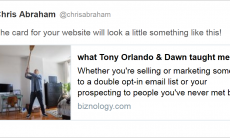I recently had the pleasure of participating in a B2B digital marketing forum hosted by The Conference Board and led by Mike Moran and Tim Peter. Mike invited me because of all the experience in B2B digital marketing I have accumulated at IBM, much of which we distilled into our book Outside-In Marketing: Using Big Data to Guide Your Content Marketing.
The lively discussion covered a lot of ground, reflecting the needs of marketing executives striving to do digital well. Digital is a different animal from traditional marketing. As expected, the executives in attendance asked frank questions about how to do the aspects of their mission they tend to struggle with. I prepared for a lot of questions on the prime topics in our book: digital transformation, content strategy, SEO, agile marketing, and digital design. Instead we got a lot of questions on influencer marketing. They all seemed to grasp the concept, but had difficulty putting it into practice.
I guess I shouldn’t be surprised at their interest in the topic. According to Forbes, influencer marketing is exploding in popularity. The article points to the the root cause of the growth of influencer marketing: waning consumer attention to generic brand messages. This makes sense. We tune out ads on TV and in digital. But we pay attention to messages delivered from people we know and trust. A typical question from the forum probed how to identify these influencers and help them market your products for you.
In B2C marketing, this is done by hiring popular people to subtly endorse your product, primarily in social media. But in B2B marketing, celebrity endorsements often appear like the hype in the ads audiences tune out. And brands that turn their social channels into faceless brand bullhorns often fail. What B2B buyers need is authentic voices from within the company, primarily from product managers and development leads. These are the people who know the most about the products and can give the “inside” information B2B buyers are hungry for.
As I said, the attendees seemed to grasp this concept, but they struggled to implement the approach. The challenges are considerable:
- How do you teach development leads to write well enough to get their points across?
Techies are not known for their ability to make complex technical information accessible to those unfamiliar with the products they build. - How do you give product managers the incentives to stretch beyond their “day jobs?”
It’s not part of their job description and their incentives are typically about things like growing market share for their products against competitors. It’s really hard convincing them to invest considerable time and energy on a side interest, for any length of time. - Even if you manage to recruit and train subject matter experts (SMEs) to write regularly, how do you manage their work?
If they’re already stretched for time, getting them on an editorial calendar and coordinating their efforts to optimize their collections of content for the audience is tough.
Fortunately, I had one ready answer in my work at IBM. In one of my first jobs at IBM, I was the editor of a team of SMEs who wrote for a very narrow audience–the independent software vendors (ISVs) who built products for our hardware platforms. Based on my research, what they wrote about was also highly relevant to clients and prospects. So we built a system to surface their content to the masses, strung the content together into typical user journeys, and optimized it for search engines.
The year before we did this, I edited 280 white papers (average length, 40 pages). After all that grueling work, I really wanted to know how many times those white papers were downloaded in that year. So I asked the analytics person.
The answer: “25.”
“25 a piece?” I asked.
“No, 25 total.”
Also, only five of the pieces had any downloads at all. Needless to say, this increased my desire to optimize the content so that clients and prospects could find it in the relevant steps on their buyer journeys. At the end of that year, I asked the analytics person again.
The answer: “150,000, total.” That’s more like it.
The message of for the Conference Board attendees was simple: chances are, you already have a lot of the content your clients and prospects are looking for. It’s just hidden from them. So job 1 is to find pockets of good content in your company and work on getting it shared in your social channels, and indexed and ranked by search engines.
How to do B2B influencer marketing
But that tactic still doesn’t answer their questions. They wanted to know how to identify, train, and manage SMEs for ongoing influencer marketing campaigns. For that, I am not an expert. But I promised I would get them the best answer I could. To do that, I called my colleague and friend Susan Emerick. She co-wrote the book The Most Powerful Brand on Earth, which is the definitive guide to influencer marketing.
Susan is a pioneer in this kind of influencer marketing. When I asked her how she did it, she told the story of Steve Will, one of her first influencers to really become a star for his brand—IBM i—for which he is the chief architect. (IBM i is formerly known as AS 400, iSeries, System i, i5 OS, and iSystem.)
Steve has been blogging and tweeting about his brand successfully since 2009. At first, he shared the You and i blog with his friend and colleague Craig Johnson. But Craig died in a car accident not long after the start of the blog. Steve’s tribute blog post about Craig topped out at 8000 views. That spurred him to keep the blog and its related Twitter handle growing in Craig’s absence. A typical announcement post gets about 5000 views. Between announcements, he averages about 3000 views and his average time on page is almost 7 minutes. Those numbers have been pretty consistent for eight years.
“Our customers and prospects were hungry for more information about our product roadmap,” Steve said in a recent interview. IBM doesn’t pre-announce features, and marketing is not allowed to do so. But Steve’s authority as the brand champion gives him a unique platform to publish this inside information.
“I was writing for a while when Susan approached me to help me do a better job on the blog and the Twitter handle,” Steve said in an interview. “She taught me to keep the posts under 1500 words to allow someone to get through each of them in a reasonable amount of time. Also, she taught me to avoid using clever blog titles but try to get the key themes of the blog in the title, to make searching easier.”
“The number 1 thing I do is to use the social avenues to tell my audience about what they need about the platform, and nothing extraneous,” Steve said. He created the Steve_Will_IBMi handle specifically for that, leaving his personal handle for extraneous things about his life and views.
“The second thing is to let my personality come through,” he added. That makes sense. So much branded content is written from the voice of the company rather than from its champions. The audience tends to tune that stuff out like advertising content.
“And, over the years, there have been a few periods when I was lax about getting new entries published. When my rate of writing dropped, the page views dropped—unsurprisingly. However, when I started publishing more regularly again, the numbers returned to what they are today.”
Steve also gets help from an agency—MSP TechMedia—which edits his work and helps to build collections of content that make sense to the audience. The Conference Board attendees should make particular note of that. Few companies have the ability to manage blog platforms and social influencer accounts in house. You might be able to identify your brand champions. But if you don’t do a lot of publishing, you should hire an agency for editing and publishing support, and channel management.
One other thing to note in Steve’s case, his manager built incentives into his job to reward him for things like blog views and Twitter followers. As I know in my own case, writing is hard work. It’s hard enough doing my day job, let alone maintaining a blog for years at a time.




